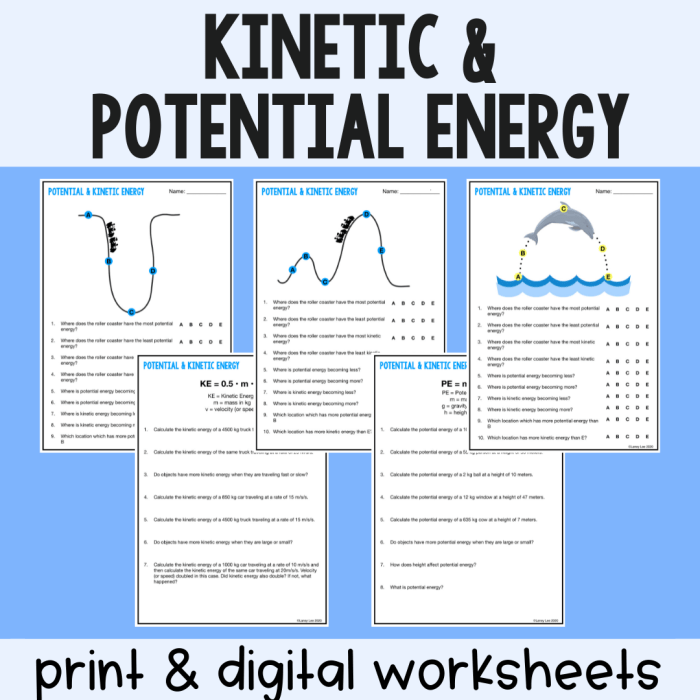Embark on a captivating journey into the realm of energy with our comprehensive kinetic energy and potential energy worksheet. Delve into the intricacies of these fundamental concepts, unravel their relationship, and witness their practical applications in everyday life.
This meticulously crafted worksheet unravels the mysteries of kinetic energy, the energy possessed by objects in motion, and potential energy, the energy stored within objects due to their position or condition. Explore real-world examples, delve into the underlying formulas, and gain a deeper understanding of the interplay between these two forms of energy.
Kinetic Energy
Kinetic energy is the energy possessed by an object due to its motion. It is directly proportional to the object’s mass and the square of its velocity.
Examples of objects with kinetic energy:
- A moving car
- A rolling ball
- A flying bird
Formula for calculating kinetic energy:
Ek = 1/2 mv^2
Where:
- Ek is the kinetic energy in joules (J)
- m is the mass of the object in kilograms (kg)
- v is the velocity of the object in meters per second (m/s)
Potential Energy
Potential energy is the energy possessed by an object due to its position or condition. It is directly proportional to the object’s mass, height, or elastic deformation.
Examples of objects with potential energy:
- A book on a shelf
- A stretched rubber band
- A coiled spring
Formula for calculating potential energy:
- Gravitational potential energy:Ep = mgh
- Elastic potential energy:Ep = 1/2 kx^2
Where:
- Ep is the potential energy in joules (J)
- m is the mass of the object in kilograms (kg)
- g is the acceleration due to gravity (9.8 m/s^2)
- h is the height of the object in meters (m)
- k is the spring constant in newtons per meter (N/m)
- x is the displacement of the spring in meters (m)
Relationship between Kinetic and Potential Energy: Kinetic Energy And Potential Energy Worksheet

Kinetic energy and potential energy are interconvertible. When an object moves, its kinetic energy can be converted into potential energy, and vice versa.
Examples of kinetic energy being converted to potential energy:
- A ball thrown into the air
- A car climbing a hill
Examples of potential energy being converted to kinetic energy:
- A ball falling from a height
- A car rolling down a hill
Conservation of energy:In these conversions, the total energy (kinetic + potential) remains constant.
Applications of Kinetic and Potential Energy
Kinetic and potential energy have numerous applications in everyday life, including:
- Transportation:Cars, trains, and airplanes use kinetic energy to move.
- Construction:Cranes use potential energy to lift heavy objects.
- Sports:Athletes use kinetic and potential energy to perform various movements.
- Engineering:Engineers design structures to withstand the effects of kinetic and potential energy.
Understanding these concepts is essential in various fields, including physics, engineering, and sports.
FAQ Section
What is the formula for kinetic energy?
Kinetic energy (KE) is calculated using the formula: KE = 1/2 – m – v^2, where m represents the mass of the object and v represents its velocity.
How is potential energy related to height?
Potential energy (PE) due to height is calculated using the formula: PE = m – g – h, where m represents the mass of the object, g represents the acceleration due to gravity, and h represents the height of the object.
